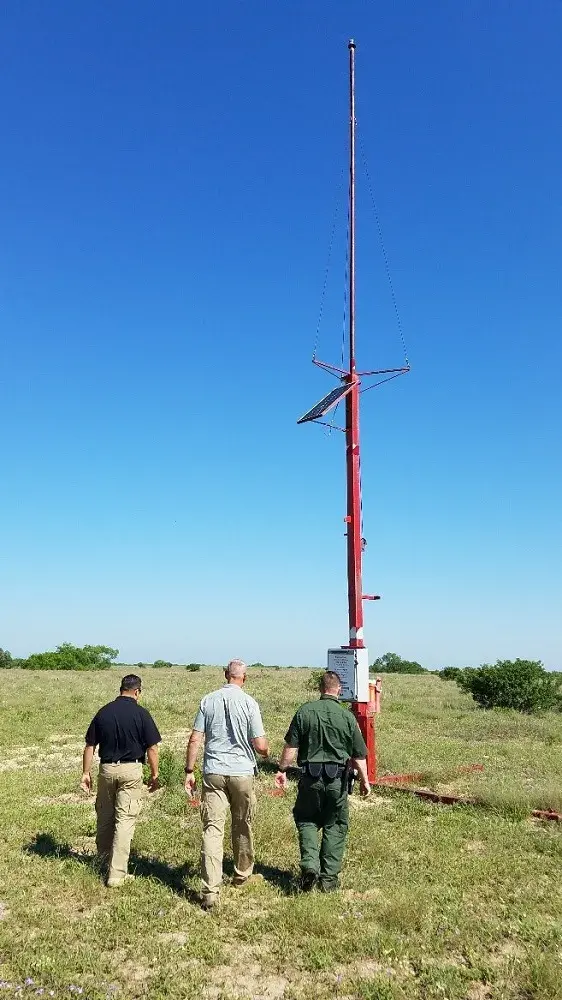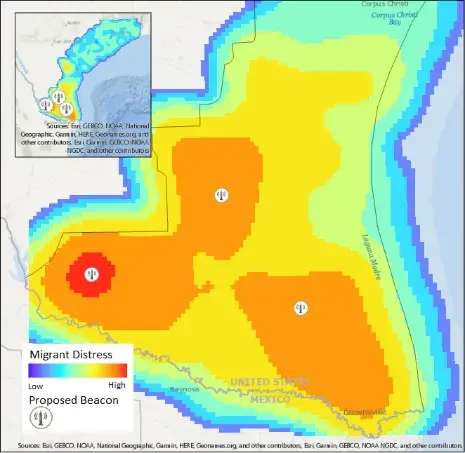Every day, undocumented migrants attempt to enter the U.S. between the ports of entry, specifically at our southwest border. Oftentimes, they face life-threatening circumstances. They are miles away from shelter, food, and water; exposed to harsh terrain and drastic changes in temperature; and lack the means to receive help if they need it. When faced with these types of adversities, migrants have a high risk of becoming disoriented, dehydrated, and succumbing to the harsh environment before they can reach help.
 In an effort to more effectively monitor migrant activity and provide life-saving aid when needed, U.S. Customs and Border Protection’s (CBP) Data Science Division (DSD) and Enterprise Data Analytics Office recently collaborated with the Department of Homeland Security (DHS) Science and Technology Directorate (S&T) to implement the Missing Migrants Program.
In an effort to more effectively monitor migrant activity and provide life-saving aid when needed, U.S. Customs and Border Protection’s (CBP) Data Science Division (DSD) and Enterprise Data Analytics Office recently collaborated with the Department of Homeland Security (DHS) Science and Technology Directorate (S&T) to implement the Missing Migrants Program.
“The primary objective of the Missing Migrants Program is to improve our ability to save the lives of migrants that are attempting to enter the U.S. between the ports of entry at our southwest border or circumvent our immigration checkpoints,” said DHS S&T Program Manager Lorraine Castillo.
To help notify U.S. Border Patrol when migrants are in distress and provide a general location of where they may be, CBP has placed rescue beacons and 911 rescue placards throughout parts of the southwest border, specifically the Rio Grande Valley, that are frequently traveled by migrants or have posed a threat to them in the past. The rescue beacons, when utilized or directly activated by a distressed subject, contacts CBP and notifies Border Patrol Agents that there is an emergency in the immediate area. The informational placards provide migrants with emergency contact information in English and Spanish that they can use to contact emergency management services (e.g. 911) if needed. They also provide a general location that agents can use to begin their search for migrants, if necessary.
“The rescue beacons and 911 rescue placards are useful tools for anyone who may be in distress in the border area, and for the CBP Border Patrol agents who respond to calls for assistance,” explained CBP Program Advisor Derek McVay. “However, to ensure maximum effectiveness and accessibility, they need to be strategically placed -- ideally on accessible terrain and within range of cellular reception. Cell signals are the way that we are able to triangulate the locations of migrants and initiate rescues.”
“Our 911 rescue placards are our simplest and most accessible rescue aid,” continued McVay. “They can be put almost anywhere and utilized by migrants who need them. As long as they have access to both a cell phone and cellular reception, they will be able to call 911 for help. For migrants who may not have access to a cellphone, we have our rescue beacons. These are similar to the emergency blue lights that you see on college campuses, and serve as a ‘save me’ button. When they push the button on one of our rescue beacons, it automatically sends out a 911 distress signal to law enforcement, which is then routed to our Border Patrol Agents to notify them that a rescue is needed.”
However, the rescue beacons and 911 rescue placards have their shortcomings.
“Our rescue beacons and placards are reliant upon the availability of cellular services and associated infrastructure,” explained Patrick Trulock, CBP Director of Enterprise Services. “And some parts of the southwest border simply do not have cellular reception. So, if we are not thoughtful about where we place our rescue beacons and placards, we can render them ineffective.”
“Physical terrain also serves as a big challenge when considering where to put these tools,” Trulock continued. “If they aren’t accessible to migrants, they are useless.”
 To address these concerns, S&T’s Missing Migrant Program recently developed and piloted two key tools in the Rio Grande Valley sector from April to August 2019: an interactive dashboard that enhances CBP’s ability to display and interact with geospatial data and models to help them strategically install additional rescue beacons and 911 rescue placards, and an analysis playbook that supports the development of similar dashboards in other sectors of the southwest border.
To address these concerns, S&T’s Missing Migrant Program recently developed and piloted two key tools in the Rio Grande Valley sector from April to August 2019: an interactive dashboard that enhances CBP’s ability to display and interact with geospatial data and models to help them strategically install additional rescue beacons and 911 rescue placards, and an analysis playbook that supports the development of similar dashboards in other sectors of the southwest border.
The dashboard works by identifying, collecting, and importing CBP DSD sector-specific geospatial data sets (both historical and current) into ArcGIS Portal, thus enabling Border Patrol Agents to quickly access information related to:
- Geography -- e.g., elevation, types of terrain, visibility of the terrain, types of vegetation, flood zones;
- Land use;
- Locations and accessibility of water and water sources; current 911 rescue placards and beacons; cellular towers; CBP facilities and other relevant structures; property lines, gates, restricted areas that may impact response routes and times; roads and trails;
- Seasonal conditions – e.g., weather, temperature, rainfall; and
- Routes frequented by migrants – e.g., popular travel routes, routes where rescues tend to take place, routes where apprehensions have taken place, and routes where migrants have died in the past, along with dates and times of encounters.
The playbook serves as a user guide that provides a workflow of repeatable processes, methodologies, and data dictionary to other sectors that may want to implement a dashboard similar to the one that was piloted in the Rio Grande Valley sector of the southwest border.
Both the dashboard and playbook were successfully piloted and then transitioned to CBP in October 2019.
“Our initial pilot of the dashboard and playbook in the Rio Grande Valley proved to be very successful,” said Castillo. “By giving CBP improved capabilities to see and interact with geospatial data from this sector, they have been able to more effectively model the landscape and make better decisions related to locations and deployments of rescue beacons and placards. So far, we’ve been able to ensure that our new 911 rescue placards are being placed within walking distance of cellular reception, beacons are being placed within immediate range of cellular reception, and that both of these rescue tools are being placed in physically accessible terrain that is frequented by migrants.”
“We’re excited about the possibilities that the dashboard and playbook have made available to us,” said McVay. “Our long-term goal is to finesse these tools to the point where they can be universally implemented and be efficient enough to be used in real-time when agents are conducting rescue responses in the field.”
Since the pilot of the dashboard and playbook ended in October 2019, the Missing Migrant Program has:
- Begun production on an additional 40 rescue beacons and over 500 911 rescue placards;
- Received over $1 million in funding and executed the purchase of rescue infrastructure for nine other southwest border sectors; and
- Begun rolling out the dashboard and playbook to other sectors of the southwest border so that Border Patrol Agents in these sectors can plan for the future placement of rescue beacons and placards in their regions.
For fiscal year 2020, the Missing Migrant Program has received an additional $3 million to enhance rescue efforts for nine other southwest border sectors. They have also partnered with five major electrical companies and gas companies in South Texas to gain access to over 22,000 electrical and gas infrastructure landmarks (e.g.., electric pole lines, transformers, and gas pipelines), expand CBP’s ability to identify landmarks through GPS coordinates, and enhance their ability to place beacons and 911 rescue placards more accurately.
